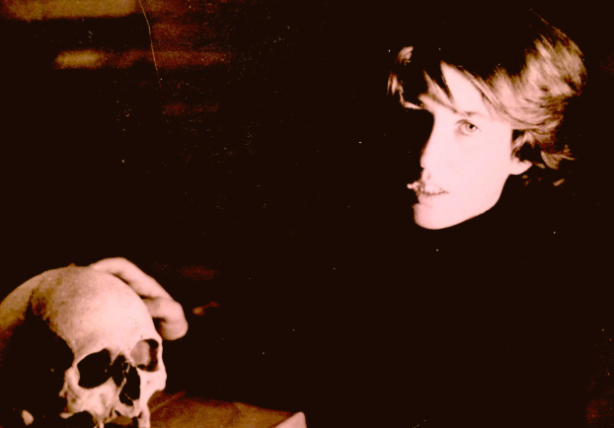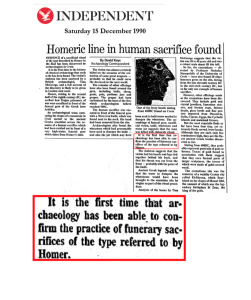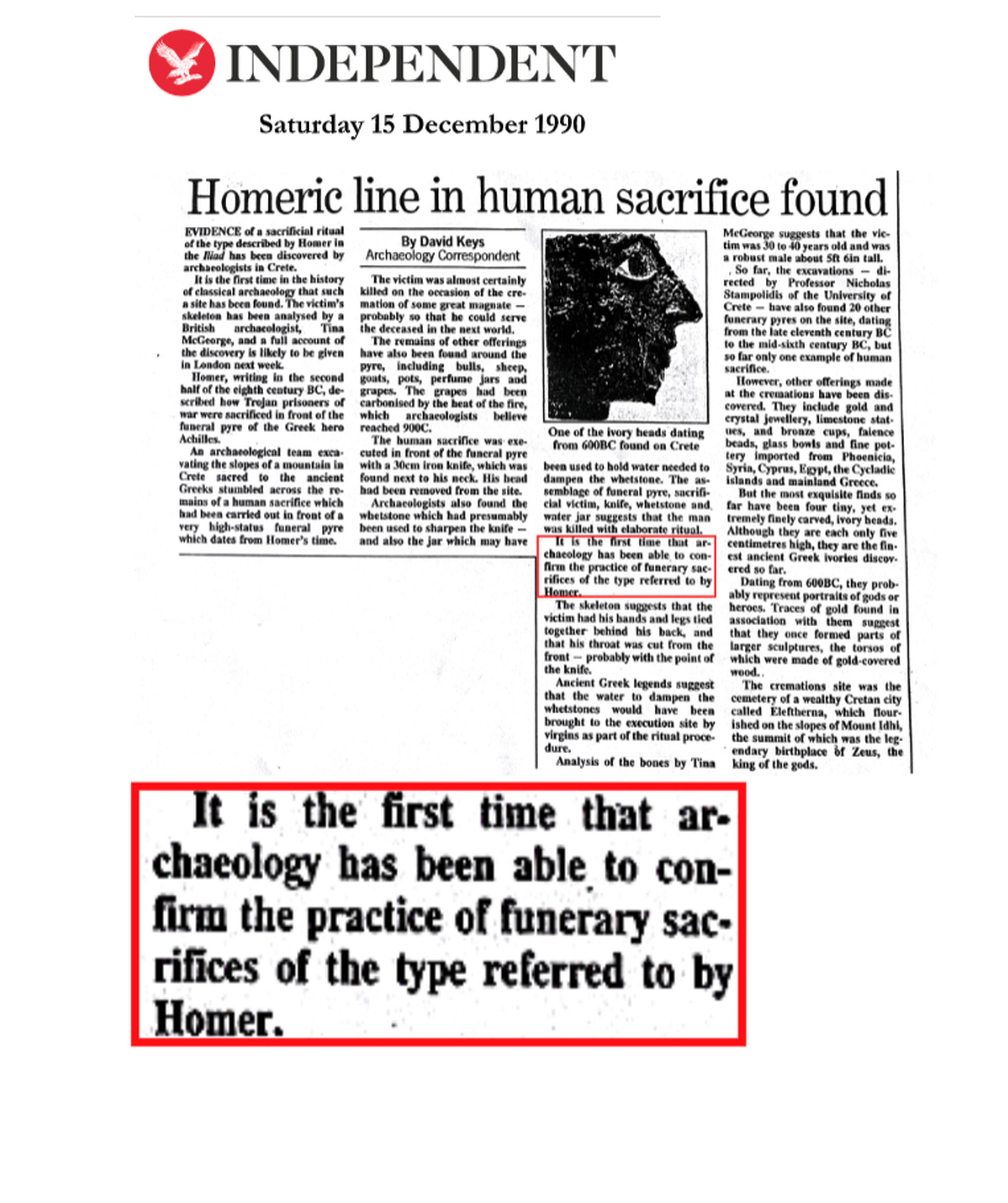Profile
Tina McGeorge has worked as a researcher and consultant on the excavation, rescue, and museum presentation of human remains from archaeological sites in Europe, mainly in Greece, but also in the Near East (at Tell Abu Hureyra in Syria, Nahal Oren in Israel, Jericho exhibit at the British Museum) and North Africa (Zincechra, Saniat Ben Huwedy & other sites in the Fezzan).
From 2004 -2006 Tina McGeorge taught anthropology and gender archaeology to under-graduates at the University of Crete, Rethymnon campus, and acted as a supervisor and examiner for postgraduates from 2001 -2010.

1987 Leverhulme Research Fellowship
1984 – 86 Royal Society of Great Britain Postdoctoral Research Fellowship.
1980 – 82 IKY – Greek Government Scholarship.
1983 PhD Institute of Archaeology University of London.
1973 MA Institute of Archaeology University of London.
1971 BA Institute of Archaeology University of London.
Palaeopathology
Trauma
Medical practice in prehistoric times
Cosmological beliefs
Infant burials
Human sacrifice
aDNA
Facial reconstruction
Xombourgo (Vardalakos) Cemetery, Tenos (University of Athens)
Hagios Charalambos Human Bone Project, Lasithi (at Instap)
Human remains from the Late Minoan cemeteries of Chania (Ephoreia)
Infant Burials at Knossos (British School at Athens)
Infant Burials at Akrotiri ( University of Athens)
The Levantine cemetery at Buca, Smyrna
Η ΑΡΧΟΝΤΙΣΣΑ ΤΟΥ ΙΠΠΕΙΟΥ Α Μέρος – YouTube. ERT Aigaiou – (View Video)
Η ΑΡΧΟΝΤΙΣΣΑ ΤΟΥ ΙΠΠΕΙΟΥ Β Μέρος – YouTube. ERT Aigaiou – (View Video)
“The Lady of Ippeios: The archaeological discovery of a human tragedy 28 centuries old. Αρχόντισσα του Ιππείου: Αρχαιολογική ανακάλυψη μιας ανθρώπινης τραγωδία 28 αιώνων!” Ελεύθερος Τύπος, Πολιτισμός, May 4, 2019.
“A human sacrifice on Kastelli Hill during the 13th century B.C. Η ανθρωποθυσία στο Λόφο Καστέλι κατά τον 13ο αιώνα π. Χ.” Efsyn.gr, November 13, 2019.
“Homeric line in human sacrifice found.” The Independent, December 15, 1993. (View Article)
- 2024 McGeorge P.J.P.: HUMAN SACRIFICE. The Archaeological Context of Greek Mythology – ΑΝΘΡΩΠΟΘΥΣΙΑ. Το αρχαιολογικό πλαίσιο της ελληνικής μυθολογίας. Mediterranean Anthropological Society – Kedros
- 2009 Paschalides C./ McGeorge P.J.P.: The LMIII Cemetery at Tourloti, Siteia. BAR International Series Vol. 1917
- 1992 Hallager B.P./McGeorge P.J.P.: “Late Minoan III Burials at Khania” SIMA Vol. XCIII.
2023 McGeorge, Tina. “A Burial of the Early Christian Period in the Sanctuary at Symi”. EULIMENE 23 (December):97-107. https://doi.org/10.12681/eul.36311.
2023 Skourtanioti, E., Ringbauer, H., Gnecchi Ruscone, G.A. et al. Ancient DNA reveals admixture history and endogamy in the prehistoric Aegean. Nat Ecol Evol 7, 290–303 (2023). https://doi.org/10.1038/s41559-022-01952-3
2022 Gunnar U. Neumann, Eirini Skourtanioti, Marta Burri, Elizabeth A. Nelson, Megan Michel, Alina N. Hiss, Photini J.P. McGeorge, Philip P. Betancourt, Maria A. Spyrou, Johannes Krause, Philipp W. Stockhammer,
Ancient Yersinia pestis and Salmonella enterica genomes from Bronze Age Crete, Current Biology, Volume 32, Issue 162021 Ανάδειξη αρχαιολογικού χώρου Καβειρίου Λήμνου (The enhancement of the archaeological site of Lemnos, (Ed) P. Triantafyllidis, Archaeological Ephoreia of Lesbos, (forthcoming).
2021 “Anthropological Remains from Mycenaean Tombs at Kompotadhes in the Sperchios Valley: First Impressions”, Γ΄ Διεθνές Διεπιστημονικό Συμπόσιο Η Περιφέρεια του Μυκηναϊκού Κόσμου, Lamia 18.05.2018.
2020 McGeorge et al, «A Palaeopathological Investigation of Geopoiesis of a 5th Century BC Brain from Tenos”, Πάλαιο-Ογκολογία: Ιστορική ανασκόπηση του καρκίνου από την αρχαιότητα μέχρι τον 21ο Αιώνα. Πρακτικά του 2ου Διεθνούς Συμποσίου της Ευρωπαϊκής Εταιρείας Ιστορίας της Ογκολογίας. 1η Νοεμβρίου 2019. Athens Academy. Κέντρον Ερεύνης της Ελληνικής και Λατινικής Γραμματείας, Αθήναι 2020, σ. 69 -79.
2020 «Palaeo-Oncological Findings from Prehistoric Crete», Πάλαιο-Ογκολογία: Ιστορική ανασκόπηση του καρκίνου από τη αρχαιότητα μέχρι τον 21ο Αιώνα. Πρακτικά του 2ου Διεθνούς Συμποσίου της Ευρωπαϊκής Εταιρείας Ιστορίας της Ογκολογίας. 1η Νοεμβρίου 2019. Athens Academy. Κέντρον Ερεύνης της Ελληνικής και Λατινικής Γραμματείας, Αθήναι 2020, σ. 81- 91.
2019 «Post-Mycenaean burials from Lindos», Ημερίδα στη Μνήμη του Καθηγητή Σπύρου Ιακωβίδη, University of Athens, 243 – 249.
2019 Paschalidis C./McGeorge P.J.P./Wieckowski W.: The Mycenaean Cemetery at Achaia Clauss near Patras: People, material remains and culture in context, Archaeopress Archaeology.
2018 “Human Skeletons from a Late Minoan IIIA2-Β Chamber Tomb at Galia in the Messara” Bulletin de Correspondance Hellénique BCH 142.1(2015), 49-70. https://doi.org/10.4000/bch.286.
2017 “Platyvola Cave: Archaeological Context and Carbon 14 Dates”, Addendum: to Ε. Πρωτοπαπαδάκη: ‘Κυκλαδίζον ειδώλιο Προανακτορικής περιόδου από την Πλατυβόλα Χανίων’, in N. Stambolidis/ P. Sotirakopoulou: Cycladica in Crete, University of Crete/ Cycladic Museum of Art, Rethymnon 2017, 446.
2017 “The Early Cycladic Infant Burials at Akrotiri” in Doumas (ed.) 40th Anniversary of the Akrotiri Excavations (2008), Αρχαιολογική Εταιρεία Αθηνών (forthcoming).
2017 “The Pit L Baby Burial – Hermeneutics: Implications for immigration into Kydonia in MMIII/LMI” Proceedings of the Danish Institute of Archaeology No. 8(2017), 293-304.
2017 McGeorge in Lazaridis, I., Mittnik, A., Patterson, N. et al. Genetic origins of the Minoans and Mycenaeans. Nature 548, 214–218 (2017). doi.org/10.1038/nature23310
2016 “Due sepolture a enchytrismos del TMIIIb all’ interno di una casa a Festos” Pasiphae X (2016), 145-176.
2016 “Pithos Burials at Pre-Eruption Thera” 10th ICAANE (2016), OREA, Austrian Academy of Sciences, Vienna (forthcoming).
2016 McGeorge/Watrous: “Minoan Burials under the Phylakeion at Gournia, East Crete”. 10th ICAANE (2016), OREA, Austrian Academy of Sciences,Vienna (forthcoming).
2015 “The earliest evidence for a Mycenaean Greek ritual form of human sacrifice” Pasiphae IX (2015), 43-51.
2013 “Intramural Infant Burials in the Aegean Bronze Age: Reflections on symbolism and eschatology with particular reference to Crete” in Olivier Henry (éd.) Le Mort dans La Ville, Institut Français d’Études Anatoliennes Georges Dumézil – CRNS USR 3131, Istanbul.
2013 Review of The Greek Swedish Excavations at the Agia Aikaterini Square Kastelli, Khania, 1970–1987 and 2001. The Late Minoan IIIB:1 and IIIA:2 Settlements. Volume IV: 1 & 2 The Classical Review, Vol. 63 / Issue 01 /April 2013, pp 228 230 – doi.org:10.1017/S0009840X12003150 Published online: 01 March 2013.
2013 “An Intramural Burial at the Early Christian Basilica of Kato Symi: A death in childbirth?”(forthcoming).
2013 Καράντζαλη/McGeorge «Η διαχρονική χρήση του νεκροταφείου στον Προφήτη Ηλία στις Κομποτάδες Φθιώτιδας: Μια πρώτη προσέγγιση με βάση τα ευρήματα του τάφου ΙV .Human bones from an LHIIIC Tomb at Kompotades, Lamia: Continuity, Treatment and Functions of Ancestral Remains» Φθιωτική Ιστορία, Πρακτικά 5ου Συνεδρίου Φθιτωικής Ιστορίας,16-18 Απριλίου 2010, 51-94.
2011 “Trauma, Surgery and Prehistoric Events” Proceedings of 10th Cretological Congress,vol. A1 (2006), 299-313, Φιλολογικός Σύλλογος «Ο Χρυςόστομος» Χανιά 2011.
2011 “The intramural Jar burial at Petras: Context, Symbolism & Eschatology” in Petras Siteia, 25 years of Excavations and Studies, Danish Institute at Athens, Monograph 16, 291 ff.
2010 Paschalidis/McGeorge “Life and death in the Periphery of the Mycenaean World at the end of the Late Bronze Age The case of the Achaea Klauss Cemetery” in E.Borgna From the Aegean to the Adriatic, Social Organisation and Modes of Exchange and Interaction in Post-palatial Times (12th –11th centuries B.C.). International Workshop, Udine 1-2 December 2006.
2009 Paschalidis/McGeorge: “The Cremation Burial from Plakalona, Tourloti” in The LMIII Cemetery at Tourloti, Siteia, BAR IS Vol. 1917, Oxford.
2009 “Gender Meta-analysis of LBA skeletal remains: The case of Tomb 2 in the Pylona Cemetery on Rhodes” in K. Kopaka, ‘Fylo. Engendering Prehistoric ‘Stratigraphies’ in the Aegean and the Mediterranean, Proceedings of an International Conference, University of Crete, Rethymno 2-5 June 2005, Aegeum 30, 103-114. [Mysteriously, editorial confusion not only omitted the first column from the table, but also managed to alter my first name to ‘Penelope’ !]
2008 Betancourt/McGeorge: The Human Remains (p.) in “Excavations in the Hagios Charalambos Cave”, Hesperia, 2008 77: 578-596.
2008 “Morbidity & Medical Practice in Minoan Crete”, Chapter 15 in: From the land of the Labyrinth Minoan Crete, 3000-1100 B.C. Essays, Onassis Foundation.
2003 “Intramural infant burials in the Aegean” in E & BP Hallager (ed.s) The Greek Swedish Excavations at the Aghia Aikaterini Square, Kastelli, Khania 1970-1987 & 2001 VOL III: 1 , 301-3.
2001 Karantzali/McGeorge: The Mycenaean Cemetery at Rhodes, BAR IS Vol. 9881.
1995 Karantzali/McGeorge: Siamese twins in Rhodes «Σιαμαία δίδυμα στη Ρόδο» Η Πόλη της Ρόδου από την ‘Ιδρυση της μέχρι την Κατάληψη από τους Τούρκους (1523), Πρακτικά, Τόμος Α , 153-162.
1994 “Oι άνθρωποι της Πυλώνας” (The people of Pylona) in Dacoronia ( ed.) Η Περιφέρεια του Μυκηναϊκού Κόσμου Α’, Διεθνές Συμπόσιο, Λαμία, 1994 301-302
1993 Article with illustrations and photographs, plus a video film of the Pyre Burial and the Human Sacrifice from Eleutherna (which were subsequently used by the excavator for his publications, TV documentaries, and a museum exhibit). See: Stampolides N.Ch.: ΕΛΕΥΘΕΡΝΑ. Από τη γεωμετρική και αρχαϊκή νεκρόπολη. Ταφικές πυρές και ομηρικά έπη, Ρέθυμνον 1994. Stampolides N.Ch.: ΑΝΤΙΠΟΙΝΑ «Reprisals: Contribution to the study of Customs of the Geometric -Archaic Period», Rethymnon1996.
1991 “Ανθρωπολογία –Μέθοδοι και Τεχνικές: Το Παρελθόν το Παρόν και το Μέλλον” , “Anthropology – Methods and Techniques: The Past the Present and the Future”, Κρητική Εστία, 11-24.
1990 «Mean life expectation of the Minoans» Proc. 6th Cretological Cοngress, 419-428.
1988 “Μυθικοί Πυγμαίοι και Γίγαντες Νέα στοιχεία για το ύψος των Μινωίτων”, “Mythical pygmies and giants. New data or the stature on the Minoans”, Κρητική Εστία 2, pp. 9-18.
1988 “Health and Diet in Minoan Times” in Jones/ Catling (eds) New Aspects of Archaeological Science in Greece, BSA Occ. Paper No 3 Fitch Laboratory, pp. 47-54.
1987 “Νέα Στοιχεία για το Μέσο όρο Ζωής στη Μινωική Κρήτη” “ New data for mean age at death in Minoan Crete” , Κρητική Εστία 1, p. 9-15.
1987 “Biosocial Evolution in Bronze Age Crete” in Ειλαπίνη, Τόμος Τιμητικός για το Καθηγητή Νικόλαο Πλάτων, Ηράκλειο 1987, Eilapini,Volume in honour of Professor Nicholas Platon pp. 408- 416.
1987 Andreadaki–Vlazaki/ McGeorge: «An Early Greek Child Burial at Gavalomouri» SΜΕΕΑ ΧΧVI, Rome.
1987 McGeorge/ Mavroudis: 1987, “The incidence of osteoporosis in Bronze Age Crete” Journal of Paleopathology, 1: 37.
1986 “A comparative study of the mean life expectation of the Minoans” Πεπραγμένα του ΣΤ’ Κρητολογικοῦ Συνεδρίου Α1 1986, Χανιά 1990.
1984 “Έγκλημα στην Υστερομινωική Περίοδο Αρχαιολογία”: 11:12-16. The article was re-published in French under the title “Enquete sur un meutre”, in Archeologie, May 1986, under the name Photini Thomai who, perhaps flatteringly, considered the article worth plagiarizing word for word!
1981 “Preliminary Report: Human skeletons from the Armenoi Excavation 1976”, Apx. Ανάλεκτα, XIII:2
1977 Olivier/ McGeorge: “Mallia: I. Fouille de sauvetage en B7/c2 II. Fouille d’Urgence de L’entrée du «Charnier No. 4» en C4/ 5-6”, Bulletin de Correspondance Hellénique, p.701-703.
2009 Invited speaker opening the Conference of Orthopaedic Surgeons, Heraklion Crete.
1988 Anthropological Society Conference papers presented: On Osteoporosis & On Stature in the late Bronze Age, Athens Greece.
1987 Histoire de Medecine Conference, with a paper on Minoan Orthopaedics, Antibes, France.
1986 Centenary Conference of the British School at Athens, at Cambridge, England. Paper on: Investigating Patriarchy and Matriarchy and the form of marriage in Late Bronze Age Crete through non-metrical variation and consideration of the possibilities offered by DNA analysis of human remains Cambridge, England.


